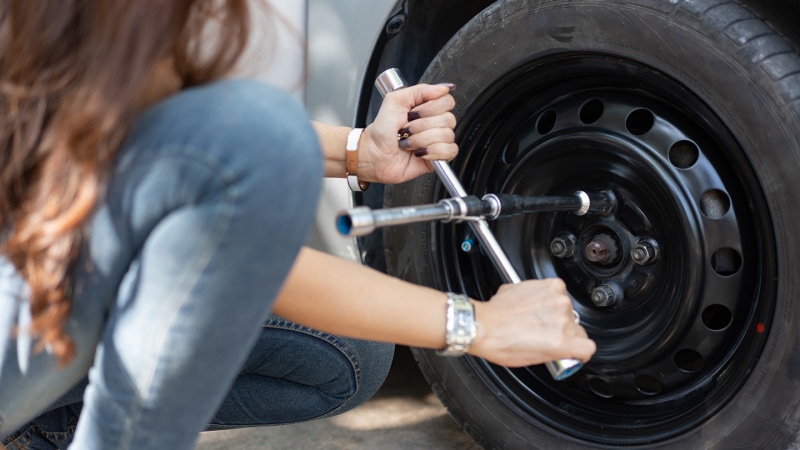How to change a flat tire

Quick insights
- Before you change a tire, your vehicle should be on a flat surface with the parking brake engaged.
- The essential items include the spare tire, a car jack and a lug wrench.
- With the critical items and a general guide, you can put on a spare tire safely and efficiently to get back on the road.
Whether you’ve never changed a flat tire or need a refresher, here’s a guide to help you through the process.
Checklist: What do you need to put on a spare tire?
There are only a few items you absolutely need to change a flat tire, but many other items can make the process smoother or more comfortable.
Essentials
Without these items, you may need to call for a tow truck or roadside assistance when you get a flat tire:
- Spare tire: On most vehicles, spare tires can be mounted on the rear door, underneath the vehicle, or kept in the trunk or rear cargo area.
- Jack: If your car comes equipped with a jack, it will likely be in the same cargo area as the spare tire or in the trunk.
- Lug wrench: You’ll use this to remove and tighten lug nuts — often located with your spare tire.
Nice to have
These are useful items to have on hand when changing a flat, or even in emergencies:
- Tire pressure gauge: This can confirm your tires are inflated to safe levels.
- Air compressor: Sometimes, spare tires might deflate a bit if they go untouched for years. A compressor could help you reinflate a spare tire on the spot.
- Tire blocks: Also called wheel wedges or chocks, they provide extra support to prevent your car from rolling.
- Flashlight: Changing a flat tire in the dark is generally more difficult — a headlamp or lantern would work, too.
- Reflective material: Safety cones, a reflective jacket (or vest) and anything to increase your visibility to passing drivers.
- Protection: A poncho or rain jacket will be nice if you have to change a flat in the rain. Gloves would protect your hands from getting dirty when handling tires and tools. Otherwise, a tarp, blanket or knee pad can protect your clothes from getting dirty.
How to put on a spare tire
To help you continue on your journey or reach a professional service area, here are several steps to change a flat tire:
1. Prepare the car and supplies
Consider moving your car as far away from traffic as you can. However, parking on a flat, stable surface is also important. Put the car in park, then engage the emergency brake and hazard lights. Retrieve the spare tire, lug wrench and jack. If you have additional supplies, such as a tarp, reflective vest or traffic cones, situate them before continuing.
2. Loosen the lug nuts
You’re just loosening the nuts at this step, not removing them. If the tire has a hubcap, remove it to expose the lug nuts. Turn the lug wrench counterclockwise to loosen.
3. Use the jack to lift the car
The owner’s manual should specify where you place the jack and how to operate it. If you’ve bought an upgraded jack, follow its instructions for use. Six inches off the ground usually provides enough clearance to remove the flat tire and install the new one.
4. Remove the lug nuts, then the tire
The lug nuts you loosened earlier can be removed, so the tire can slide off the lug posts. Pull the tire straight out.
5. Put the spare tire on
Start by aligning the holes on the wheel to the lug posts, then push the tire in place. Apply pressure to ensure the wheel is on as far as it will go, careful not to push too hard. Then you can add one lug nut at a time — go in a diagonal or star pattern — tightening each one by turning the lug wrench clockwise. You don’t have to try tightening each lug nut as far as it will go.
6. Lower the car and tighten the lug nuts
Use the jack to lower the car to the ground, then ensure the lug nuts are tightened snuggly. Again, you can move in a diagonal or star pattern.
7. Confirm the tire pressure, if possible
You can usually find the recommended PSI for regular tires on the inside edge of your driver-side door. If the spare tire is not a regular size, however, check its recommended PSI. Use a gauge to check the pressure of your spare tire. If you have an air compressor, adjust the tire pressure as needed.
How long does it take to change a spare tire?
The time it takes could depend on your experience level, but changing a tire might take about 30 minutes. Each phase could take about 5 minutes: gather tools; loosen lug nuts; lift the car; remove the flat and install the spare; lower the car; tighten lug nuts.
Are spare tires universal?
Spare tires aren’t universal — they’re designed to match your vehicle’s specs. The size, speed rating and load capacity vary, so using a spare tire that doesn’t match your car can be risky. The handling could change, and your other tires could suffer more wear. If your car doesn’t have a spare tire, it may have a repair kit or run-flat tires instead. The kit could include an aerosol can that you can spray to temporarily patch or inflate a tire. A run-flat tire, even punctured, could maintain enough air for a short distance. You may not need to change a tire before you get to a shop for a replacement.
Types of spare tires
- Full-size: The tire itself might not match your others exactly, but the size and specs of a full-size spare can allow you to drive normally.
- Donut: Typically compact and lightweight, donut spares save space when stored. They’re not meant for long-term use or high speeds.
In summary
A flat tire doesn’t have to ruin your day. You can put on a spare tire safely and efficiently when you have the right supplies and know-how. Most spares, even full-size, aren’t meant for long distances or high speeds, which is important to know when driving. After you change a flat, visit a trusted mechanic or dealer service center to replace the busted tire, and return the spare to its original spot.



